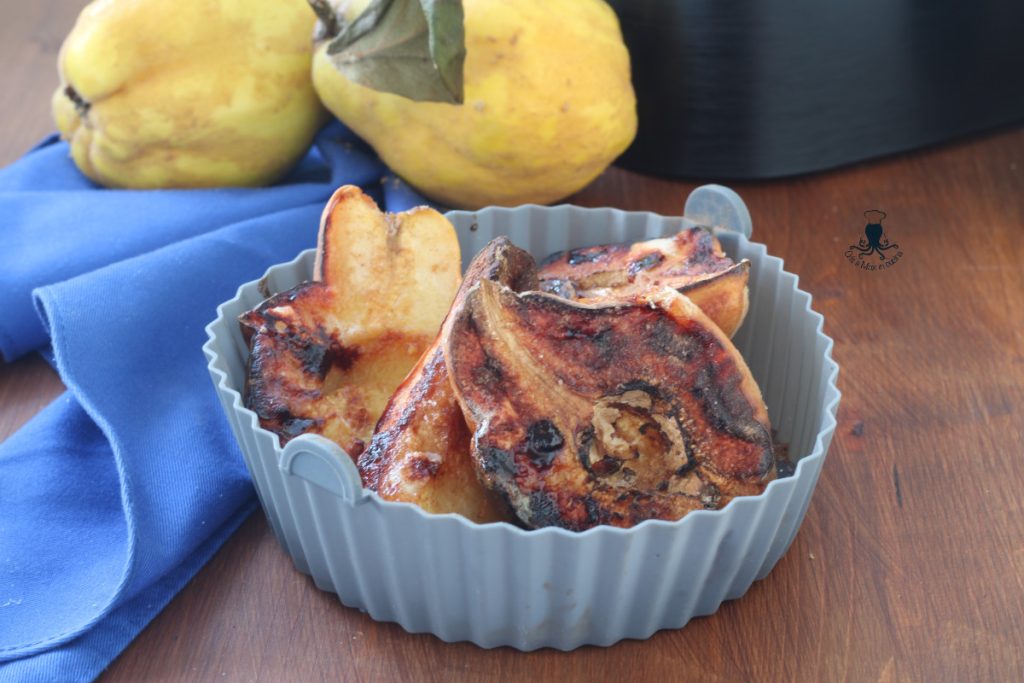Quince pears in air fryer or oven, an ancient and rustic fruit known for its hard texture and sour taste, making it unsuitable for raw consumption. However, once cooked, it releases a unique sweetness and delicate aroma with floral and honey notes. Quince pears are rich in pectin, making them ideal for preparing jams, jellies, and desserts.
Quince pears are found in many regions of Italy, in Piedmont they are found in the hilly areas of Langhe and Monferrato and are used for the preparation of Piedmontese fruit mustard where they are cooked with sugar and flavors to obtain a preserve to accompany cheeses and boiled meats. They are available in local markets from September to November.
They are also found in Abruzzo, in Molise where they are used for preparing jams, in Veneto and Friuli Venezia Giulia for the preparation of mustard, in Emilia Romagna they accompany quince pear jam with Parmigiano Reggiano.

- Difficulty: Very Easy
- Cost: Very Economical
- Preparation time: 10 Minutes
- Portions: 2 people
- Cooking methods: Electric Oven, Air Frying
- Cuisine: Italian
- Seasonality: Autumn
Ingredients for quince pears in air fryer or oven:
- 2 quince pears
- 2 tablespoons granulated sugar (or cane sugar or honey)
- 1/2 lemon (the juice)
- as needed cinnamon
Tools for quince pears in air fryer or oven:
- 1 Oven
- 1 Knife
- 1 Silicone Baking Tray for Air Fryer
Steps for preparing and cooking quince pears in air fryer or oven:
Wash the quince pears thoroughly, you will notice they are covered by a light fuzz, to remove it just rub them well under running water.
Cut the pears in half (use a sharp knife as they are quite hard to divide), then remove the core.
For air fryer cooking: place the pears inside a silicone container or a baking tray that fits in the air fryer (in this case line it with parchment paper), spray lemon juice over the fruit then add the granulated sugar, cane sugar, or a little honey and sprinkle with ground cinnamon (optional).
Cook at 356°F (180°C) for about 20 minutes (once cooked, the tines of the fork should easily insert into the pear pulp); if they are still a bit hard, continue cooking for another 3/4 minutes.
For oven cooking: place the halved pears in a tray lined with parchment paper, spray the lemon juice, then add the cane or granulated sugar or honey and sprinkle with cinnamon if desired.
Also add a small cup of water to the tray.
Bake in a preheated oven at 356°F (180°C) for about 30/35 minutes; they should be tender and caramelized.
Let them cool slightly before enjoying them; they are perfect accompanied by some thick yogurt.
Characteristics of this fruit.
The quince pear has been known since the times of the ancient Greeks and Romans.
Once cooked, they release an intense floral scent that perfumes the entire house.
They are rich in fiber, vitamins (especially vitamin C), and antioxidants, beneficial for digestion and the immune system. Additionally, they have a lower sugar content than other fruits, making them suitable for low-calorie diets.
Thanks to their high pectin content, quince pears turn into a gelatinous consistency when cooked. This makes them ideal for making jams and jellies without adding artificial thickeners.
During cooking, the flesh of quince pears can change color, from light yellow to a deep pink or red, depending on the variety and cooking time.
Quince pears are also used in savory dishes, such as stews and roasts, especially when combined with meats like pork or lamb, to which they add a sweet and tangy note that balances the flavors.
Quince pears, once harvested, can be stored for weeks or even months in a cool place. Over time, they become even more fragrant, maintaining their quality and aromatic intensity.
The quince pear has been known since the times of the ancient Greeks and Romans.
Once cooked, they release an intense floral scent that perfumes the entire house.
They are rich in fiber, vitamins (especially vitamin C), and antioxidants, beneficial for digestion and the immune system. Additionally, they have a lower sugar content than other fruits, making them suitable for low-calorie diets.
Thanks to their high pectin content, quince pears turn into a gelatinous consistency when cooked. This makes them ideal for making jams and jellies without adding artificial thickeners.
During cooking, the flesh of quince pears can change color, from light yellow to a deep pink or red, depending on the variety and cooking time.
Quince pears are also used in savory dishes, such as stews and roasts, especially when combined with meats like pork or lamb, to which they add a sweet and tangy note that balances the flavors.
Quince pears, once harvested, can be stored for weeks or even months in a cool place. Over time, they become even more fragrant, maintaining their quality and aromatic intensity.
FAQ (Questions and Answers)
What’s the difference between quince pears and quince apples?
The main difference is in the shape and texture of the fruit, with apples tending to have a denser texture compared to pears.

